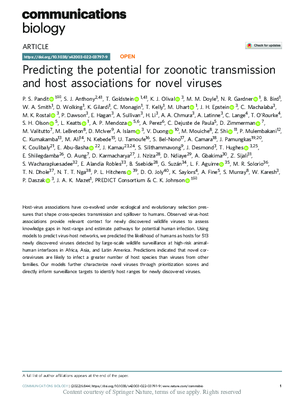Predicting the Potential for Zoonotic Transmission and Host Associations for Novel Viruses
Host-virus associations have co-evolved under ecological and evolutionary selection pressures that shape cross-species transmission and spillover to humans. Observed virus-host associations provide relevant context for newly discovered wildlife viruses to assess knowledge gaps in host-range and estimate pathways for potential human infection. Using models to predict virus-host networks, we predicted the likelihood of humans as hosts for 513 newly discovered viruses detected by large-scale wildlife surveillance at high-risk animal-human interfaces in Africa, Asia, and Latin America.
https://biodiversitylinks.org/learning-evidence/one-health-evidence/one-health-evidence-inbox/predicting-the-potential-for-zoonotic-transmission-and-host-associations-for-novel-viruses.pdf/view
https://biodiversitylinks.org/learning-evidence/one-health-evidence/one-health-evidence-inbox/predicting-the-potential-for-zoonotic-transmission-and-host-associations-for-novel-viruses.pdf/@@download/image/image.png
File
Predicting the Potential for Zoonotic Transmission and Host Associations for Novel Viruses
Author(s):
Communications Biology
Publication Date: 2022
DOWNLOAD FILE
Host-virus associations have co-evolved under ecological and evolutionary selection pressures that shape cross-species transmission and spillover to humans. Observed virus-host associations provide relevant context for newly discovered wildlife viruses to assess knowledge gaps in host-range and estimate pathways for potential human infection. Using models to predict virus-host networks, we predicted the likelihood of humans as hosts for 513 newly discovered viruses detected by large-scale wildlife surveillance at high-risk animal-human interfaces in Africa, Asia, and Latin America.



